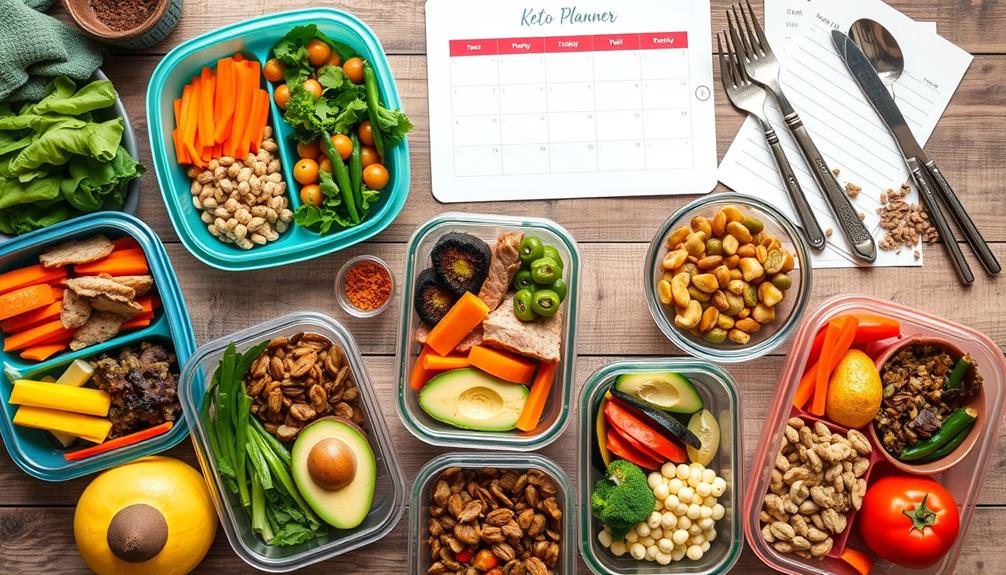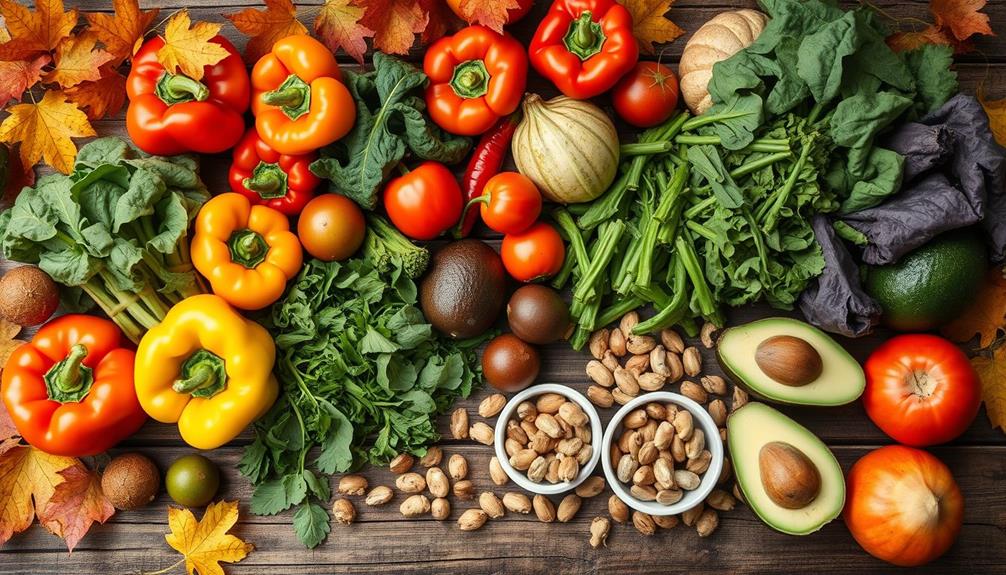To stay on the keto diet, you need to focus on meal planning and monitoring your macronutrients. Aim for a daily intake of 20-50 grams of carbohydrates, with 60-75% of your calories from healthy fats. Include plenty of non-starchy vegetables and healthy snacks like nuts and cheese to curb cravings. Regular exercise can help, too, as it boosts ketone production. Don't forget to track your ketone levels to guarantee you're in ketosis. By staying organized and motivated, you can stick to the lifestyle and achieve your goals—there's always more tips and tricks to explore! Consider consulting with a healthcare professional or nutritionist to ensure you’re meeting your nutritional needs. Additionally, pay attention to how your body responds to the diet, as individual tolerance can vary. It’s important to also be mindful of the duration of ketogenic diet, as prolonged adherence may have different effects on different individuals. Always prioritize your health and well-being when making dietary choices.
Key Takeaways
- Plan meals weekly with high-fat, low-carb foods to ensure balanced nutrition and adherence to the keto diet.
- Track macronutrient intake using apps like Cronometer to stay within keto guidelines.
- Incorporate regular exercise, including resistance training and HIIT, to boost ketone production and enhance fat loss.
- Stay hydrated and maintain electrolyte balance to avoid symptoms of keto flu and support overall health.
- Engage with online keto communities for support, motivation, and sharing of meal prep tips and recipes.
Understanding Ketosis

Ketosis is like flipping a switch in your metabolism, where your body shifts from burning carbohydrates to utilizing fat as its primary energy source. This metabolic state typically occurs when you reduce your carbohydrate intake to about 20-50 grams per day.
As you adhere to a low carb diet, your liver begins to convert fatty acids into ketone bodies, which serve as an alternative energy source for your brain and muscles. This process leads to elevated ketone levels in your bloodstream. Additionally, incorporating foods rich in antioxidants, such as celery juice, can support your overall health while on a keto diet.
Generally, it takes about 2-4 days of consistent low carb intake to enter ketosis, but individual factors like your metabolism and activity level can affect how quickly you feel the shift.
You might notice signs of ketosis, such as increased energy levels, reduced hunger, and improved cognitive function. However, you may also experience the "keto flu" during this initial adaptation phase, which can include flu-like symptoms.
To stay on track, consider monitoring your ketone levels with breath, urine, or blood tests. This way, you can gauge your state of ketosis and adjust your dietary habits as needed to maintain this beneficial metabolic state.
Essential Dietary Guidelines

Maintaining success on the keto diet hinges on understanding and following essential dietary guidelines. By adhering to these principles, you'll better manage your weight and health. Here are three key guidelines to keep in mind:
1. Macronutrient Ratio: Aim for about 60-75% of your calories from fat, 15-30% from protein, and only 5-10% from carbohydrates. This will help keep your daily carb intake between 20-50 grams, maintaining ketosis.
It's also important to take into account the potential side effects and interactions of certain foods and supplements, especially if you're combining the keto diet with natural remedies alongside conventional medications.
2. Focus on High-Fat Foods: Incorporate high-fat foods like avocados, nuts, seeds, and olive oil into your meals. Choose moderate protein sources such as fish, poultry, and eggs while limiting carbs from grains, sugars, and starchy vegetables.
3. Include Non-Starchy Vegetables: Don't forget to add non-starchy vegetables like leafy greens and broccoli to your diet. They're packed with essential nutrients, vitamins, and antioxidants while keeping your carb intake low.
To track your progress, think about using apps like Cronometer, which can help guarantee you're sticking to your macronutrient ratio.
With these guidelines, you'll confidently navigate your low-carb diet and enjoy its many benefits.
Meal Planning Strategies

When you take the time to plan your meals for the week ahead, you're setting yourself up for success on the keto diet. Incorporate a variety of high-fat, low-carb foods like avocados, nuts, and leafy greens. This guarantees balanced nutrition and helps you avoid impulsive eating.
Additionally, consider using coffee as part of your meal strategy; for instance, incorporating innovative coffee gear can enhance your brewing experience and provide a satisfying low-carb beverage option.
Create a detailed grocery list based on your meal plan, focusing on whole, unprocessed foods. Steer clear of high-carb items like bread, pasta, and sugary snacks that can derail your progress.
Batch-cook or prep meals in advance, such as keto-friendly casseroles, to make sticking to your diet easier during busy days.
Utilize apps like Cronometer or MyFitnessPal to track your macronutrient intake. Aim for 60-75% fat, 15-30% protein, and 5-10% carbohydrates to stay on target.
Experiment with different keto recipes to keep your meals interesting. Incorporate various cooking methods and flavors to enhance your dining experience, preventing boredom and making mealtime enjoyable.
With effective meal planning, you'll find it easier to maintain your keto lifestyle and reach your health goals. Remember, success on keto starts with a solid plan!
Healthy Snack Options

Snacking can be a delicious and satisfying part of your keto journey, and having healthy options on hand makes it easy to stay on track.
When you choose snacks rich in healthy fats, low carb foods, and protein foods, you'll keep cravings at bay while fueling your body.
Additionally, incorporating treats that promote overall health, like healthy dog snacks, can be a fun way to share the keto experience with your pets.
Here are three excellent snack options to contemplate:
- Nuts and Seeds: A variety of nuts, like almonds and walnuts, offer about 5-6 grams of net carbs per ounce. They're packed with healthy fats and make for a crunchy, satisfying snack.
- Cheese: Cheese sticks or slices contain less than 1 gram of carbs per ounce and are full of protein and calcium. They're quick, easy, and keep you feeling full longer.
- Hard-Boiled Eggs: With less than 1 gram of carbs each, hard-boiled eggs are a powerhouse of high-quality protein and healthy fats. They're perfect for on-the-go snacking.
Role of Exercise

To maximize your success on the keto diet, incorporating regular exercise is key. Engaging in activities like resistance training or HIIT not only helps deplete glycogen stores but also boosts ketone production.
Additionally, practices like yoga can enhance flexibility and reduce stress, which may further support your metabolic health. By making movement a daily habit, you'll enhance your metabolic health and support your body's shift into ketosis.
For example, yoga for back pain can be an excellent way to integrate gentle movement into your routine.
Exercise Types and Benefits
Incorporating various types of exercise into your routine not only enhances your overall health but also supports your journey on the keto diet. Engaging in regular physical activity helps deplete glycogen stores, accelerating your shift into ketosis and promoting fat utilization for energy.
Additionally, essential oils such as eucalyptus and peppermint can help support respiratory health, which may enhance your exercise performance and recovery essential oils for wellness.
Here are three effective exercise types to take into account:
- Resistance Training: Weightlifting not only preserves muscle mass during a ketogenic diet but also boosts your metabolic rate and improves insulin sensitivity, making it crucial for long-term weight loss.
- High-Intensity Interval Training (HIIT): This exercise type can greatly increase ketone production and enhance cardiovascular health, making it an excellent choice while you're on the ketogenic diet.
- Aerobic Activities: Swimming, jogging, or cycling can improve your overall fitness and support weight loss by aligning with the keto goal of burning fat for fuel.
Additionally, regular exercise can help alleviate symptoms of "keto flu" by improving your mood and energy levels through endorphin release.
Incorporating Movement Daily
Finding ways to incorporate movement into your daily routine is essential for maximizing the benefits of the keto diet. Engaging in at least 30 minutes of moderate exercise each day can help deplete glycogen stores, promoting the production of ketones for energy. This is vital for maintaining ketosis and optimizing your results.
Additionally, regular physical activity can enhance overall well-being, much like the support resources available for caregivers dealing with various challenges in elderly care support resources available.
Resistance training, like weightlifting, is another key component. It enhances muscle preservation while you're on a ketogenic diet, supporting your overall body composition and metabolic health.
Additionally, consider high-intensity interval training (HIIT), which is particularly effective for boosting fat oxidation and increasing ketone levels due to its glycogen-depleting effects.
Regular physical activity also improves insulin sensitivity, which is beneficial for managing blood sugar levels. To further aid in weight management, incorporate movement throughout your day—take the stairs instead of the elevator, or go for short walks during breaks.
These small changes contribute to overall caloric expenditure, enhancing the effects of ketosis. By making exercise a consistent part of your routine, you'll not only support your weight management goals but also enjoy the myriad benefits of an active lifestyle.
Intermittent Fasting Benefits

Intermittent fasting offers a range of benefits that can greatly enhance your ketogenic diet experience. By incorporating intermittent fasting into your routine, you can accelerate your shift into ketosis and improve your overall metabolic health.
Additionally, it's important to manage potential risks associated with dietary changes, such as avoiding gold IRA scams, which can parallel the need for thorough research in any investment decision.
Here are three key benefits:
- Increased Fat Loss: Combining intermittent fasting with the ketogenic diet can lead to greater fat loss compared to dieting alone, as fasting helps deplete glycogen stores more rapidly.
- Improved Insulin Sensitivity: Fasting periods can enhance insulin sensitivity, which is particularly beneficial for managing blood sugar levels, especially for individuals with type 2 diabetes.
- Reduced Inflammation: Research shows that intermittent fasting may help lower inflammation and oxidative stress, contributing to better health outcomes while on a ketogenic diet.
Additionally, intermittent fasting can help curb your appetite and reduce overall calorie intake, making it easier to stick to the strict macronutrient ratios of the ketogenic diet.
Monitoring Ketone Levels
Tracking your ketone levels is vital for optimizing your ketogenic diet. By monitoring ketone levels, you can determine how well your body is entering and maintaining ketosis. There are three primary methods to test ketones: breath, urine, and blood.
While ketone strips provide a quick indication of ketone levels through color changes, they may not be the most reliable for long-term monitoring. Understanding the importance of sustainable weight loss can also enhance your commitment to the keto lifestyle. The Ketonix meter offers a non-invasive way to measure acetone in your breath, but for the most accurate readings, a blood ketone meter is your best option.
Regular testing is essential, especially during the initial phase of your ketogenic journey. Aim for blood ketone levels between 0.5 and 3.0 mmol/L to guarantee you're in nutritional ketosis.
You'll likely experience fluctuations in your ketone levels as your body adapts, so consistent monitoring will help you identify the best dietary practices. This clarity not only helps you stay on track but also provides motivation as you see the direct impact of your dietary choices.
Common Challenges

You might find social situations tricky when you're on a keto diet, especially with all the tempting high-carb foods around.
To help navigate these challenges, consider engaging in family activities that incorporate creative projects, which can keep your mind off cravings.
Cravings for carbs can crop up, challenging your resolve and making it harder to stay on track.
Recognizing these struggles early can help you develop strategies to manage them effectively.
Social Situations Struggles
Maneuvering social situations can be one of the toughest challenges for anyone committed to a keto diet. High-carb foods dominate most gatherings, leaving you feeling excluded or tempted to stray from your goals. Peer pressure can further complicate matters, often leading you to consume more carbs than planned.
Here are three strategies to help you navigate these tricky scenarios:
- Pre-Planning: If you're heading to a potluck or restaurant, consider reviewing the menu or asking about the dishes beforehand. This way, you can identify keto-friendly options and avoid hidden sugars.
- Communicate: Don't hesitate to talk to your friends and family about your dietary preferences. Clear communication can help them understand your needs, and they may even make accommodations to support your keto diet.
- Bring Your Own Dish: When attending gatherings, bringing a keto-friendly dish guarantees you have something safe to enjoy while also introducing others to delicious low-carb options.
Cravings and Temptations
Cravings for carbs often hit hard when starting the keto diet, especially during the initial adjustment phase known as "keto flu." As your body shifts from burning glucose to fat for energy, it's common to feel those intense urges for sugary or starchy foods.
To combat these cravings, keep keto-friendly snacks like nuts, cheese, and hard-boiled eggs readily available. Having these on hand helps manage hunger between meals and prevents impulsive high-carb choices.
Incorporating more healthy fats into your meals—think avocados, olive oil, and fatty fish—can enhance your satiety and reduce the likelihood of cravings. Staying hydrated is also vital; dehydration can worsen cravings and lead to feelings of fatigue.
So, drink plenty of water and consider adding electrolytes to your routine.
Meal planning is important for staying on track. By planning your meals and snacks ahead of time, you can avoid temptations and guarantee that you're always stocked with keto-friendly options.
This proactive approach makes it easier to stick to your diet and overcome those pesky cravings. Remember, you're not alone in this—many others face the same challenges as you do!
Nutrient Considerations

How can you guarantee your body gets all the essential nutrients while following a ketogenic diet? The key lies in being mindful of your nutrient intake.
First, focus on electrolytes, as maintaining adequate levels of sodium, potassium, and magnesium can help you avoid the dreaded "keto flu."
Next, prioritize nutrient-dense foods like leafy greens, nuts, and seeds to combat potential vitamin and mineral deficiencies, given the limited food variety on the diet.
Finally, consider supplementing with omega-3 fatty acids from sources like fatty fish or flaxseed oil, as these will help balance the omega-6 fatty acids prevalent in some keto-friendly oils.
To confirm you're hitting your nutrient goals, follow these steps:
- Incorporate high-fiber, non-starchy vegetables into your meals for digestive health and essential vitamins.
- Use tracking apps to monitor your macronutrient intake and verify you're not missing out on crucial nutrients.
- Regularly assess your meal plan to ensure you're consuming a variety of nutrient-dense foods.
Staying Motivated and Supported

Staying motivated on a ketogenic diet can be challenging, but it's essential for long-term success. One effective way to boost your motivation is by joining online forums or social media groups focused on the keto lifestyle. These communities provide a sense of belonging and accountability, where you can share experiences, tips, and encouragement with others on the same journey.
Setting specific, achievable goals can also keep you focused. Whether you're tracking weight loss or monitoring ketone levels, celebrating small victories can fuel your motivation.
To ward off boredom, regularly update your meal plans and try new keto recipes. Variety is key to maintaining enthusiasm.
Another great strategy is to find a keto buddy or support partner. This can make meal prep and workouts more enjoyable while enhancing accountability. You'll motivate each other to stay on track.
Lastly, consider utilizing mobile apps for tracking your macronutrient intake and progress. These tools provide immediate feedback, reinforcing your commitment to the keto lifestyle.
Frequently Asked Questions
How Do I Stay on Keto?
To stay on keto, focus on maintaining your macronutrient ratios, meal prepping, tracking your carb intake, and incorporating healthy snacks. Regularly check your ketone levels to verify you're in ketosis and adjust accordingly.
How Long Can You Stay on a Keto Diet For?
Research shows that many thrive on a ketogenic diet for years. You can stay on it long-term, but regularly check your health markers and consult a professional to guarantee it's safe and effective for you.
How Do You Keep Your Body in Constant Ketosis?
To keep your body in constant ketosis, limit carbs to 20-50 grams daily, consume healthy fats, exercise regularly, consider intermittent fasting, and monitor ketone levels to adjust your diet as needed.
How Do You Stay Committed to Keto?
Staying committed to keto's like training for a marathon; you need focus and preparation. Set clear goals, plan meals, track your intake, and lean on supportive communities to keep your motivation high and cravings low.
Conclusion
Staying on the keto diet can feel like maneuvering through a maze, but with the right strategies, you can find your way. By understanding ketosis, planning meals, and choosing healthy snacks, you'll keep your energy up and cravings down. Don't forget to mix in regular exercise and monitor your ketone levels for best results. When challenges arise, lean on your support system to help you stay motivated. You've got this—just take it one step at a time!









